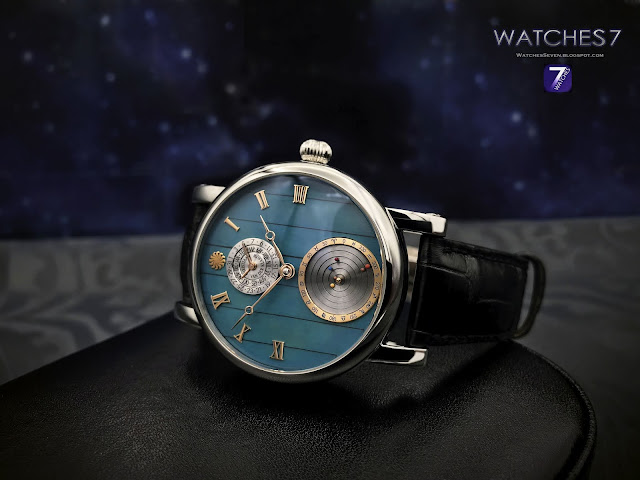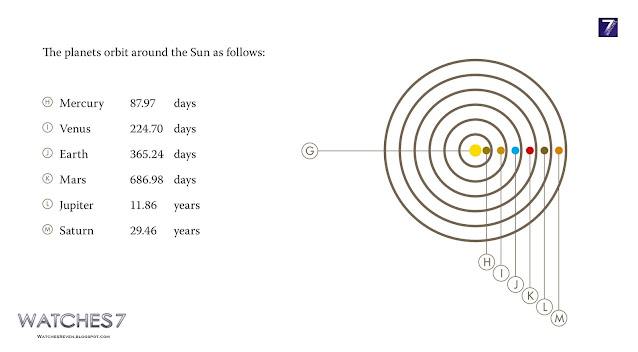Christiaan Van Der Klaauw – Astronomical Masterpieces CVDK PLANETARIUM
Eise Eisinga Limited Edition 2020
THE OLDEST WORKING PLANETARIUM IN THE WORLD
MEETS THE SMALLEST MECHANICAL PLANETARIUM IN THE WORLD...
MEETS THE SMALLEST MECHANICAL PLANETARIUM IN THE WORLD...
Click, to see the large size. ▶ BIG FOTO
A magical gathering between the oldest working Planetarium in the world and the smallest mechanical Planetarium in the world.
Christiaan van der Klaauw and the Royal Eise Eisinga Planetarium proudly present the CVDK Planetarium Eise Eisinga Limited Edition watch.
Art and science captured in an enchanting way in a hand-painted masterpiece. In a very limited edition of only 6 steel and 6 rose gold models, with each of the 6 watches will bear its own unique planet name.
This beautiful Haute Horlogerie masterpiece contains the smallest mechanical Planetarium in the world showing real time the orbits of Mercury, Venus, Earth, Mars, Jupiter and Saturn around the sun.
- ORBIT OF MERCURY: 87.97
- DAYSORBIT OF EARTH: 365.24
- DAYSORBIT OF JUPITER: 11.86
- YEARSORBIT OF SATURN: 29.46
- YEARSORBIT OF MARS: 686.98
- DAYSORBIT OF VENUS: 224.70 DAYS
THE SMALLEST MECHANICAL PLANETARIUM IN THE WORLD
This is the ultimate way to carry the universe closely to your heart. Our in-house designed module gives you the smallest mechanical heliocentric planetarium in the world.
It displays real time the solar orbits of Mercury, Venus, Earth, Mars, Jupiter and Saturn. It also shows you the minutes, hours, date and month.
The result is a magnificent spectacle that continues to fascinate in all its complex mechanical beauty. This is astronomical watchmaking at the highest level, intricately designed and executed.
Our Planetarium is one of the most complicated watches in our collection, a fitting tribute to the grand masters of planetarium design such as Nicolaas Copernicus, Johannes Kepler, Christiaan Huygens and Eise Eisinga.
This smallest mechanical Planetarium in the world is located at the 6 o’clock position. The Sun is positioned exactly in the middle of the Planetarium ۞
The planet closest to the Sun is Mercury. Mercury is followed by Venus, Earth, Mars, Jupiter and Saturn.
The planets orbit around the sun as follows:
ROYAL
EISE EISINGA PLANETARIUMDISCOVER THE SOLAR SYSTEM
THE OLDEST WORKING PLANETARIUM IN THE WORLD
EISE EISINGA PLANETARIUMDISCOVER THE SOLAR SYSTEM
THE OLDEST WORKING PLANETARIUM IN THE WORLD
DISCOVER THE SOLAR SYSTEM
Suspended from the ceiling of the living room of a beautiful canal house in Franeker, is the oldest still working planetarium in the world. This accurately moving model of the solar system was built between 1774 and 1781 by the Frisian wool comber, Eise Eisinga.
Suspended from the ceiling of the living room of a beautiful canal house in Franeker, is the oldest still working planetarium in the world. This accurately moving model of the solar system was built between 1774 and 1781 by the Frisian wool comber, Eise Eisinga.
Click, to see the large size. ▶ BIG FOTO
WHO WAS EISE EISINGA
Eise Eisinga was born in Dronrijp on February 21, 1744. He attended primary school there. Like many children, at that time, he had to work at home, which his case was in his father’s wool combing establishment. In addition to combing wool, he inherited his father’s interest in matters such as astronomy and mathematics. He was so curious that he went to Franeker every week, where he studied Euclides’s maths books with Willem Wijtses, a wool dyer. At the age of 24, Eisinga married Pietje Jacobs, after which he settled in Franeker in 1768, working as a wool comber.
THE END OF TIME
On May 8, 1774, a special constellation of planets formed. In the early morning, Mercury, Venus, Mars, Jupiter and the moon were positioned closely in the sky. It was claimed that the mutual forces of these celestial bodies would knock the earth off its path and cause it to be burned up by the sun. A preacher from Bozum, Eelco Alta, made this prediction. In April 1774, the Leeuwarder Courant published a piece about the writing of this ‘lover of truth’, as he called himself. His piece of writing carried the title: ‘Philosophical concerns about the conjunction of the planets’. Alta’s ideas caused a lot of unrest among the population. The authorities attempted to intervene by banning the piece of writing, but the damage had already been done.
NO NEED TO PANIC
Eisinga’s vast knowledge of mathematics and astronomy came in handy when, in May 1774, turmoil broke out in response to Eelco Alta’s prediction. In order to give the people a correct picture of the solar system, he built a model of the solar system in his living room. Only seven years passed between his very first idea and the final realisation of this project. Since 1781, Eisinga’s model has closely followed the paths of the 6 planets in our solar system. This makes it the oldest still-functioning planetarium in the world.
WHO WAS EISE EISINGA
Eise Eisinga was born in Dronrijp on February 21, 1744. He attended primary school there. Like many children, at that time, he had to work at home, which his case was in his father’s wool combing establishment. In addition to combing wool, he inherited his father’s interest in matters such as astronomy and mathematics. He was so curious that he went to Franeker every week, where he studied Euclides’s maths books with Willem Wijtses, a wool dyer. At the age of 24, Eisinga married Pietje Jacobs, after which he settled in Franeker in 1768, working as a wool comber.
THE END OF TIME
On May 8, 1774, a special constellation of planets formed. In the early morning, Mercury, Venus, Mars, Jupiter and the moon were positioned closely in the sky. It was claimed that the mutual forces of these celestial bodies would knock the earth off its path and cause it to be burned up by the sun. A preacher from Bozum, Eelco Alta, made this prediction. In April 1774, the Leeuwarder Courant published a piece about the writing of this ‘lover of truth’, as he called himself. His piece of writing carried the title: ‘Philosophical concerns about the conjunction of the planets’. Alta’s ideas caused a lot of unrest among the population. The authorities attempted to intervene by banning the piece of writing, but the damage had already been done.
NO NEED TO PANIC
Eisinga’s vast knowledge of mathematics and astronomy came in handy when, in May 1774, turmoil broke out in response to Eelco Alta’s prediction. In order to give the people a correct picture of the solar system, he built a model of the solar system in his living room. Only seven years passed between his very first idea and the final realisation of this project. Since 1781, Eisinga’s model has closely followed the paths of the 6 planets in our solar system. This makes it the oldest still-functioning planetarium in the world.
===============
TECHNICAL CHARACTERISTICS
Collection: Astronomical Masterpieces
TECHNICAL CHARACTERISTICS
Collection: Astronomical Masterpieces
Model: CVDK Planetarium Eise Eisinga Edition
Movement
Movement
Type: Automatic mechanical
Calibre: CVDK7386,
35 jewels, twin barrel,
Power-reserve; 96 hour max., complication; CVDK Planetarium module.
The rotor is engraved with planets, stars and the ‘Sun with 12 Claws’, the logo of Christiaan van der Klaauw.
Each case is uniquely engraved with the name of one of the 6 planets: Mercury, Venus, Earth, Mars, Jupiter or Saturn.
Click, to see the large size. ▶ BIG FOTO
Functions
Hours, minutes, complication; date, month,
Planetarium; the watch is equipped with the smallest mechanical Planetarium in the world,
showing the orbits of Mercury, Venus, Earth, Mars, Jupiter and Saturn around the Sun.
Case
Calibre: CVDK7386,
35 jewels, twin barrel,
Power-reserve; 96 hour max., complication; CVDK Planetarium module.
The rotor is engraved with planets, stars and the ‘Sun with 12 Claws’, the logo of Christiaan van der Klaauw.
Each case is uniquely engraved with the name of one of the 6 planets: Mercury, Venus, Earth, Mars, Jupiter or Saturn.
Click, to see the large size. ▶ BIG FOTO
Functions
Hours, minutes, complication; date, month,
Planetarium; the watch is equipped with the smallest mechanical Planetarium in the world,
showing the orbits of Mercury, Venus, Earth, Mars, Jupiter and Saturn around the Sun.
Case
- High quality steel Ø 40 mm
- Rose gold, Ø 40 mm
Sapphire crystal, sapphire crystal case-back.
Dial
Oil painted dial made by the artist Gaël Colon, rose gold plated indexes.
Planetarium with customized colored hand painted planets.
Strap
Black leather.
Dial
Oil painted dial made by the artist Gaël Colon, rose gold plated indexes.
Planetarium with customized colored hand painted planets.
Strap
Black leather.
- Buckle: Logo engraved steel folding clasp.
- Buckle: Logo engraved rose gold folding clasp.
Exclusive model - Unique 6 piece
PRICES : € 43,950.- steel
Limited Edition: 6 unique watches in steel, each uniquely engraved with the
name of one of the 6 planets: Mercury, Venus, Earth, Mars, Jupiter or Saturn
name of one of the 6 planets: Mercury, Venus, Earth, Mars, Jupiter or Saturn
PRICES : € 58,450.- rose gold
Limited Edition: 6 unique watches in steel, each uniquely engraved with the
name of one of the 6 planets: Mercury, Venus, Earth, Mars, Jupiter or Saturn
name of one of the 6 planets: Mercury, Venus, Earth, Mars, Jupiter or Saturn
---------------------------------------------
Press release - 2020
----------------------------------------------
Address
Christiaan van der Klaauw b.v.
Businesspark Friesland-West 47
8447 SL Heerenveen
The Netherlands
T +31 (0) 513 - 624 906
info@klaauw.com
-------------------------------------------------------
www.facebook.com - Christiaan.van.der.Klaauw
--------------------------------------------------------
www.klaauw.com



















No comments:
Post a Comment